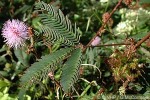Cook Islands Biodiversity Database
Species Page
Mimosa pudica
Rākau Pikika‘aSensitive Weed
Multimedia & Additional Resources
| Type | Description | Download |
| Leaf, flowers and fruit | 85KB |
General Information
Cook Islands Distribution
| Southern Group: Present Makatea: Present | ||||||||
RR |
MG |
AT |
MK |
MT |
AK |
PL |
TK |
MN |
++++ |
+ |
+L |
++ |
+L |
++++ |
+ |
- |
- |
| Northern Group: - | |||||
TN |
MH |
RK |
PK |
NS |
SW |
- |
- |
- |
X?+ |
- |
- |
Scientific Taxonomy
Mimosa pudica Linnaeus
SYNONYMS: Mimosa unijuga; Mimosa pudica var. unijuga
TAXONOMY: PLANTAE; ANTHOPHYTA (=Angiospermae); MAGNOLIOPSIDA (=Dicotyledones); ROSIDAE; Fabales (Legumes); MIMOSACEAE
More Information
SIGNIFICANCE NOTES -
POSITIVE SIGNIFICANCE: Medicine
NEGATIVE SIGNIFICANCE: Weed - serious, Injurous spines - moderate. Comments: Recognised on most islands as an injurous and very difficult to control weed in home gardens and in horticultural areas. Produces many seeds and spreads rapidly.
GENERAL NOTE: The how and why of Mimosa leaf-movement
At the base of the leaf-stalk (=petiole or rachis) and other leaf-joints there is a swelling, called a pulvinus, with extensor cells that are made rigid by having water pumped into them by cell membrane mechanisms. When the leaflets are jarred or injured the extensor cells become permeable and the water escapes - about 25% within a second - the cells lose turgor and the leaf-stalk droops and the leaflets fold face-to-face. If not disturbed again it takes about 20 minutes for the water pumps to make the extensor cells turgid thereby raising the stalks and spreading out the leaflets. Depending on the level of jarring the touch response, or Nastic Movement, is transmitted to other nearby leaves.
The nature of the signal transmitted throughout the leaf and to nearby leaves is unclear with some evidence for three mechanisms: (1) a pressure change in the sap tubes (=xylem cells); (2) a chemical reaction travelling though the sap tubes, and (3) an electrical pulse send through cell membranes.
The reason for the rapid response is debated but the main contenders relate to a defence against herbivores by: (1) exposing the stem thorns; (2) appearing less voluminous and appetizing; or (3) scaring by rapid movement. It might also reduce water loss in strong wind.
The response also occurs slowly in the evening, or under reduced afternoon light, and the leaflets remain closed throughout the night. This is called a Sleep Movement, and it occurs in many species of plants. Sleep Movement it thought to conserve water to reducing water loss through the stomata of the leaflets. [G.McCormack from many sources, 10/2005]
Vouchers & References
Vouchers:
Pukapuka: informants reported that it once grew on Motu Ko and had been eradicated (G.McCormack, 2/2004)
References:
p.687 Wagner et al.- Flowering Plants of Hawaii
p.412 Neal - In Gardens of Hawaii
p.734 Hortus 3rd
p.749 Royal Hort. Soc. Index of Garden Plants
p.546 Tropica
p.3/061 A.C.Smith - Flora Vitiensis Nova
p.278 R* Cheeseman - Flora of Rarotonga
p.59 Wilder - Flora of Rarotonga
p.395e Whistler - Ethnobotany of the Cook Islands
Data Update History (information):
zTX, zB02, zM03a, zD02, zupD05b
Web Resources
Citation Information
McCormack, Gerald (2007) Cook Islands Biodiversity Database, Version 2007.2. Cook Islands Natural Heritage Trust, Rarotonga. Online at http://cookislands.bishopmuseum.org. ![]()
Please refer to our use policy.

